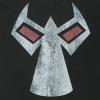Given two vectors in a 3D space. Both are simulated independently. You can think of them as edges on a collision shape of a rigid body. I need to detect when they cross over each other such that the orientation (sign) of the cross product changes. To make this less abstract here is an example:
Given two edges with vertices u1,v1 and u2,v2. At each frame I build the edges e1 = v1 - u1 and e2 = v2 - u2 and the normal n = e1 x e2. Over the time interval the edges can cross over each other creating a discontinuity in the normal direction. I am looking for a way to detect this discontinuity.
This is in the context of rigid bodies, but it might be a pretty common problem in cloth continuous collision detection. All ideas are very welcome. There is also a singularity when the edges become parallel, but this is not important initially.
Thanks,
-Dirk








